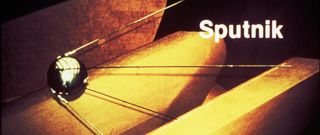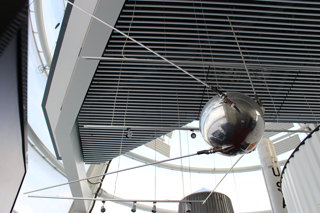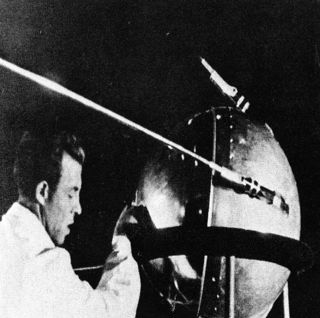
How Sputnik Changed The World
- 3rd Oct 2017
- Author: Elspeth Lewis
If you looked up to the sky on 4 October 1957, or if you had been doing some analysis on your amateur radio communicator, you could have been excused for thinking that you had found a UFO. However, what was actually in the sky, was in a way, even more exciting.
Sputnik 1 had been launched, making it the first artificial satellite to orbit the Earth. The Space Race had begun.

The launch of Sputnik was part of the International Geophysical Year (IGY); a global science project that ran between 1 July 1957 and the 31 December 1958, coinciding with a peak of the 11-year solar cycle. Both the Soviet and American governments had decided to launch an artificial satellite during the IGY. So the pressure was on!
Soviet scientists had been working on a satellite since 1954, with the Americans beginning a year later. The initial Soviet satellite was called Object D, but by late 1956 there was doubt as to whether it would be ready for launch in time. The scientific equipment was difficult to make and, at around 1000 kilograms, it was feared too heavy for launch on the rocket available.
Object D failed to become the first satellite, but did eventually fly as Sputnik 3 in 1958.
Rather than be beaten by America to the launch of the first satellite, the Soviets hurriedly went back to the drawing board and designed the more basic Sputnik 1, also known as Object PS. At 83 kilograms, the new satellite was much lighter than Object D. Sputnik was an aluminium alloy sphere with a diameter of 58 centimetres, not including the four external radio antennas.
The design meant that it could be tracked from Earth both visually and via radio transmissions. The radio antennas emitted wavelengths at two frequencies, which could be picked up using a short-wave radio receiver (listen here).
One of the scientists who worked on the launch preparations used the phrase “The simplest kind of baby moon” to describe Sputnik.

The primary scientific aim of Sputnik 1 was to test if it was possible to place a satellite into orbit. But despite its simplicity, it also provided other scientific opportunities. Sputnik made it possible to test satellite pressurisation, to study radio wave transmission and the density of the atmosphere, and allowed scientists to learn how to track objects in orbit.
Sputnik 1 orbited Earth every 96 minutes, and the fact that it passed over the USA seven times a day worried many Americans.
The American military was especially concerned by Sputnik’s weight, as it was a lot heavier than their own planned satellite. It was thought that the rocket that launched Sputnik might be able to land a nuclear weapon on the American mainland.
What became known as the Sputnik Crisis led to an immediate review of US defence systems. And there was good reason to be worried, as the rocket that launched Sputnik was originally designed to carry nuclear warheads.

Pop Culture
Whilst Sputnik was giving the American military a headache, it also gave rise to some more unusual ideas.
Ventura Salimbeni’s painting from 1595, The Glorification of the Eucharist, has been claimed to depict Jesus and God holding Sputnik. Conspiracy theorists have suggested time travel, UFOs and aliens to explain the likeness – but art historians attribute the strange object in the painting as no more than a representation of the Universe, commonly used in religious art.
Back in 1957 some religious leaders preached that Sputnik was a sign of the Second Coming of Christ. Rock star Little Richard even gave up singing for a while to become a preacher.
Sputnik has also featured in pop culture, including many songs about it, and the famous costume in Friends when Ross dressed up as ‘Spudnik’!
Early Soviet Dominance
The Sputnik Crisis left the American public anxious about the technological gap between the USA and the USSR.
Within a month of Sputnik 1, the Soviet Union followed it up with Sputnik 2, which carried the dog Laika into orbit. All this before America had launched any satellites of their own.
Things got worse a month later when the first American satellite attempt, Vanguard TV3, exploded on the launch pad. By the end of January 1958, the USA finally launched their own satellite, Explorer 1, but coming after Sputnik 2, the achievement was somewhat diminished.
By the end of July 1958 America began to strike back, setting up an organisation that would go on to become the most famous space agency of all-time – the National Aeronautics and Space Administration or NASA.
With the creation of NASA, the Space Race was well and truly underway. The two global superpowers battled it out to achieve space firsts. What had started as an peaceful international year of scientific investigation was now a competition to prove who was the most technologically advanced.
The next obvious step was to get a satellite to the Moon, or further. This step was also achieved by the Soviet Union, as Luna 1 became the first lunar spacecraft and the first human made object to orbit the Sun. The Soviets followed this with Luna 2, which became the first man-made object to impact the Moon.
While the Soviet Union continued to dominate the race to the Moon, the USA made advances in satellites for weather and communication purposes.
Moonshot
Less than four years after Sputnik 1 launched, the Soviet Union put Yuri Gagarin into orbit, becoming the first human to reach space. This incredible feat prompted president John F. Kennedy to set a finish line for the Space Race, proposing that the USA:
“should commit itself to achieving the goal, before this decade is out, of landing a man on the Moon and returning him safely to Earth”
NASA now had a definitive goal, and in 1969 Apollo 11 made history by landing the first two humans on the Moon – ultimately ensuring American success.
Of course, there were many other momentous occasions throughout the Space Race, and there have been many more since it ended.
More than 2,000 artificial satellites orbit the Earth today, with thousands of man-made objects launched into space over the last 60 years. Satellites have a huge variety of uses, from communications and GPS, to helping us forecast the weather and study the planet, to name but a few.
If you look up at the night sky it is sometimes even possible to see satellites passing overhead; not Sputnik 1 of course, its radio transmissions ceased after three weeks when its batteries ran out, and it burned up in the atmosphere four months after its launch.
Sixty years later, it is still amazing to think of all the scientific and technological advancements that have occurred thanks to that little silver ball, half the size of R2D2.
Full credits / references
(Banner image) Sputnik display at the Marshall Space Flight Centre. Credit: NASA/MSFC
(1) Sputnik 1 displayed in the National Space Centre rocket tower. Credit: National Space Centre
(2) A technician works on Sputnik 1. Credit: NASA/Asif A. Siddiqi
(3) Ventura Salimbeni's The Glorification of the Eucharist, 1595. Credit: Public Domain
(4) Luna 2, the first spacecraft to impact the Moon. Credit: NASA
(5) John F. Kennedy gives his famous speech committing the United States to land on the Moon before the decade was over. Credit: NASA
(6) Sputnik 1 displayed in the National Space Centre rocket tower. Credit: National Space Centre




